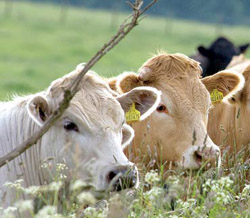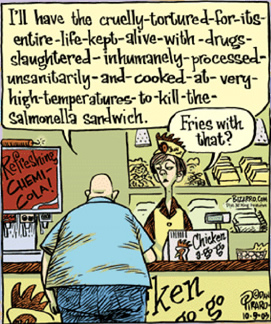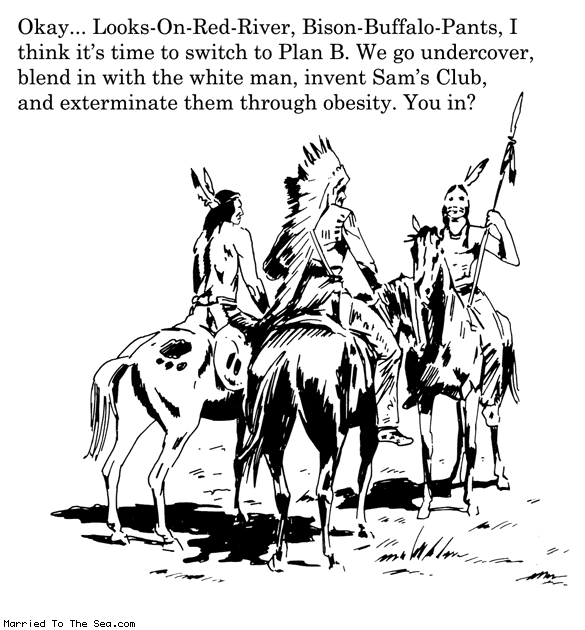Red meat is blamed for one in 10 early deaths
The Proof Is Here - Meat IS Deadly
The [UK] Department of Health has been urged to review its guidance on red meat after a study found that eating almost half the daily recommended amount can significantly increase the risk of dying early from cancer and heart disease.
According to the study, people should cut their red meat consumption to 1.5 ounces (42 grams) a day, equivalent to one large steak a week. This could prevent almost one in 10 early deaths in men and one in 13 in women.
Photo: ANDREW CROWLEY
The study found that cutting the amount of red meat in peoples’ diets to 1.5 ounces (42 grams) a day, equivalent to one large steak a week, could prevent almost one in 10 early deaths in men and one in 13 in women.
The scientists said that the government’s current advice that people should eat no more than 2.5 ounces (70 grams) a day, around the level the average Briton already consumes, was “generous”.
Dr Frank Hu, co-author of the study, said: “Given the growing evidence that even modest amounts of red meat is associated with increased risk of chronic disease and premature death, 2.5 ounces (70 grams) per day seems generous. The bottom line is that we should make red meat only an occassional rather than regular part of our diet.”
Red meat often contains high amounts of saturated fat, while bacon and salami contain large amounts of salt. Replacing red meat with poultry, fish or vegetables, whole grains and other healthy foods cut the risk of dying by up to one fifth, the study found.
It was found that for every serving of red meat - equivalent to 3 ounces (85 grams) - eaten each day there was an 18 per cent increased risk of dying from heart disease and a 10 per cent increased risk of dying from cancer.
For each serving of processed meat, equivalent to two slices of bacon or one hot dog, the risk of dying from heart disease rose by a 21 per cent and from cancer by 16 per cent.
Lead author Dr An Pan from the Department of Nutrition at Harvard, wrote in the journal: “We found that greater consumption of unprocessed and processed red meats is associated with higher mortality risk.
“Compared with red meat, other dietary components, such as fish, poultry, nuts, legumes, low-fat dairy products, and whole grains, were associated with lower risk.
“These results indicate that replacement of red meat with alternative healthy dietary components may lower the mortality risk.”
Scientists added that people who eat a diet high in red meat were also likely to be generally unhealthier because they were more likely to smoke, be overweight and not exercise.
In an accompanying editorial Dr Dean Ornish, of the University of California, San Francisco, said that eating less red meat could also help tackle climate change.
He said: “In addition to their health benefits, the food choices we make each day affect other important areas as well. What is personally sustainable is globally sustainable. What is good for you is good for our planet.”
A landmark study by the World Cancer Research Fund published in 2005 recommended that people should not eat more than 1.1lb (499 grams) of red meat a week, and that children should not be given processed meat like sausages at all.
Dr Rachel Thompson, Deputy Head of Science at the World Cancer Research Fund, said:
“This study strengthens the body of evidence which shows a link between red meat and chronic diseases such as cancer and heart disease. The research itself seems solid and is based on two large scale cohort studies monitored over a long period of time."
Dr Carrie Ruxton, from the Meat Advisory Panel (MAP), a British group of doctors and scientists funded by the industry, cast doubt on the findings and said the conclusions were based on a "theoretical" model"
She said that red meat is a valuable source of iron, zine and vitamin D which is vital for health, especially in pregnant women and infants.
A Department of Health spokesperson said: "Red meat can be part of a balanced diet. But people who eat a lot of red and processed meat should consider cutting down as regularly eating a lot could increase your risk of bowel cancer."
From The Telegraph @ http://www.telegraph.co.uk/health/healthnews/9138230/Red-meat-is-blamed-for-one-in-10-early-deaths.html
Vegetarianism vs Meat Eating: The Standoff Is Over
by Vadim Kirillov
Until recently, due to the lack of quality statistical studies, too great of a role in the great debate between vegetarians and meat eaters was played by a rhetorical component. A large-scale study involving 120,000 people showed that consumption of red meat significantly reduces life expectancy.
The position of vegetarians, due to the lack of data on long-term effects of meat diet on health, often boiled down to not always scientifically sound and ethical reasoning. The meat eaters recognized the proven harm of pre-processed (smoked, canned, freeze dried, etc.) meat and large amounts of animal fats. However, they stood their ground, indicating that the nutrient properties of freshly prepared meats (also unproven scientifically) are more important than hypothetical long-term risk of meat diet.
A large study conducted by a group of doctors from the Harvard School of Public Health, who worked under the guidance of Doctor of Medicine An Pan, revealed that fears of vegetarians are absolutely justified. Consumption of red meat is clearly correlated with a higher risk of death from cardiovascular disease, certain cancers and metabolic diseases, while the replacement of meat from mammals with fish and poultry greatly reduces this risk.
The findings are published in the Archives of Internal Medicine – the journal of the American Medical Association.
In the analysis of long-term effects on meat diet, An Pan and his colleagues relied on a statistical study of an impressive scale. A total of 37,698 men and 83,644 women participated in the study. Their health, along with the diet, was tracked for 28 years in the second group, and for 22 years in the first group. During this time, 23,926 deaths were recorded in the two groups surveyed, of which 5,910 – from cardiovascular disease and 9,464 – from cancer.
“We found that higher consumption of red meat is associated with a significant increase in mortality from these diseases, and this relationship can be traced in the case of pre-processed and freshly prepared meats, with higher correlations for the pre-processed. When replacing red meat with fish, vegetables and poultry, there was an inverse relationship – reduced mortality,” the authors commented on the results of the study.
The study revealed that in total life expectancy falls by 13% in case of daily consumption of freshly prepared meat the size of a palm, and a whopping 20% of the daily consumption of portions of pre-processed meats – a hot dog or two strips of bacon. For the disease that became the cause of death in both groups, the dependence of risks from the consumption of red meat was as follows: the risk of cardiovascular disease increased by 18% and 21% for fresh and processed meat, respectively, and cancer – by 10% and 16%.
These numbers can be considered statistically neutral, that is, free from those observed during the variables such as age, body mass index, physical activity and family history of cardiovascular disease and cancer. It is also important that all the observed members of the group were physically healthy at the start of the study.
In the second part of the analysis, the authors assessed the combined effect of replacing red meat with other foodstuffs. It was found that the risk of death in case of the exclusion of red meat from the diet is lowered if the daily portion of meat is replaced by a portion of fish (by 7%), poultry (by 14%), nuts (by 19%), vegetables (by 10%) and cereals (by 14%).
“We also found that 9.3% of deaths among men and 7.6% among women could be prevented in the observed period of time if all participants reduced their daily consumption of red meat by 50%,” summarized the researchers.
In other words, three and a half thousand men and six thousand women who participated in the study would have survived if they had cut their meat consumption by at least in half.
pravda.ru
Via Truth Theory @ http://truththeory.com/2012/03/21/vegetarians-vs-meat-eaters-standoff-is-over/
Help This Unique Site Survive
Donate any amount and receive at least one New Illuminati eBook!
Just click in the jar -
For further enlightening information enter a word or phrase into the search box @ New Illuminati or click on any label/tag at the bottom of the page @ http://nexusilluminati.blogspot.com
And see
New Illuminati – http://nexusilluminati.blogspot.com
New Illuminati on Facebook - https://www.facebook.com/the.new.illuminati
New Illuminati Youtube Channel - http://www.youtube.com/user/newilluminati/feed
The Her(m)etic Hermit - http://hermetic.blog.com
This material is published under Creative Commons Fair Use Copyright (unless an individual item is declared otherwise by copyright holder) – reproduction for non-profit use is permitted & encouraged, if you give attribution to the work & author - and please include a (preferably active) link to the original along with this notice. Feel free to make non-commercial hard (printed) or software copies or mirror sites - you never know how long something will stay glued to the web – but remember attribution! If you like what you see, please send a tiny donation or leave a comment – and thanks for reading this far…
From the New Illuminati – http://nexusilluminati.blogspot.com











